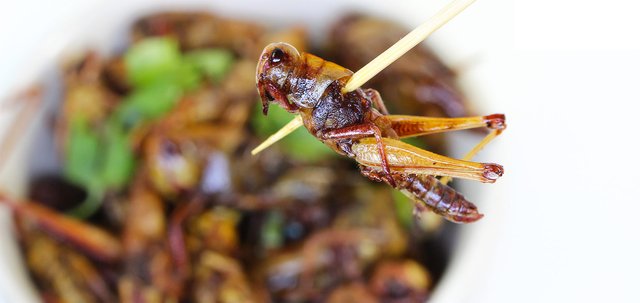
We’ll all be eating bugs soon.
As technology evolves rapidly and humanity inches ever closer to the singularity, there’s another growing trend looking to take us in the opposite direction, back to our roots as hunters and gatherers: eating insects!
But before you get grossed out, take a look at these 8 reasons why eating bugs is good for you, why it’s great for the planet, and why it could be a very profitable investment.
1. Growth of the global population by ~2 billion people will require more sustainable protein sources
The UN estimates that by 2050, the world’s population will be around 9 billion individuals. To feed that many people, the current amount of food production will need to almost double.
But there’s not nearly enough land to double output using current farming methods, crops, and livestock. Around 1/3 of the planet’s arable land is already in use for livestock (70% of all agricultural land use), which has led to continued deforestation and has put a strain on water resources as well.
Simultaneously, aquaculture has also grown considerably in recent decades, and it now accounts for around 50% of the world’s fish production. But in order to be sustainable, the supply of proteins for fish feed will also need to be met in completely new ways.
This creates a huge opportunity for insects to become a new and sustainable form of protein, replacing meat products for human consumption, and being used as feed for fish (and poultry). More on that later.
The UN’s report on edible bugs highlighted a number of reasons why the consumption of insects is advantageous:
- They have a high feed-conversion efficiency (an animal’s capacity to convert feed mass into increased body mass, represented as kg of feed per kg of weight gain).
- They can be reared on organic side streams, reducing environmental contamination, while adding value to waste.
- They emit relatively few GHG’s and relatively little ammonia.
- They require significantly less water than cattle rearing
- They have few animal welfare issues, although the extent to which insects experience pain is largely unknown.
- They pose a low risk of transmitting zoonotic infections.
So what’s the holdup? Well, it comes down to consumer acceptance in the west that insects can be viable (or should I say even “edible”) sources of protein.
Western cultures have developed a sense of squeamishness and disgust toward the idea of eating insects, based originally on the belief that to do so was barbaric and not fit for civilized society.
But apart from the visuals (which artistic chefs are now changing), there are no good nutritional reasons to avoid consuming bugs. None.
The aversion to eating insects is thus entirely based on antiquated – and elitist – western stereotypes about barbarism in other cultures, and a general preference in the modern world for mass-produced food.
That trend is beginning to shift, however, and much like the rise in popularity of lobster – once thought of as the meat of poor people and prisoners, and known as the cockroach of the sea – dietary patterns can change quickly. Quinoa sprinkled kale chips, anyone?
As you’ll see later on, the trend toward mainstream acceptance of Entomophagy (eating insects) is already underway.
2. 80% of the planet already eats bugs as a staple in their diet
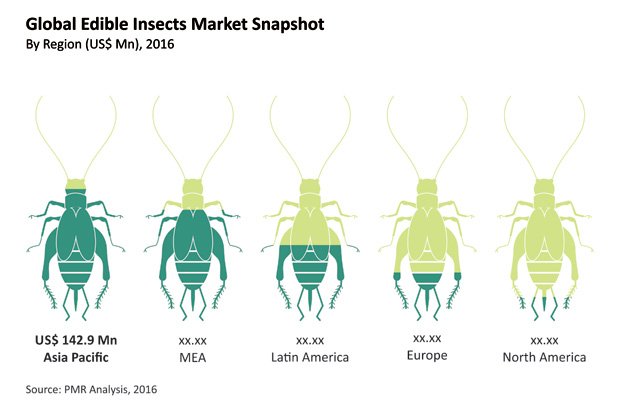
You probably didn’t know that most of the planet enjoys insects as food on a fairly regular – even daily – basis.
But an estimated 2 billion people consume insects as food, from crunchy fire ants in South America, to beetle larvae in Africa, to toasted crickets in SE Asia, and the list goes on!
The people who don’t currently eat insects are predominately squeamish westerners – mostly populations in Europe and particularly in North America.
As emerging markets grow and develop, people continue to eat bugs as a culinary delight. This isn’t merely a survival method though, people really like the taste and believe them to be a healthy, nutritious food source (they are – but more on that later).
Unfortunately, western influence in emerging markets, both in terms of food and puritanical religious views about heathen eating habits, has long exerted influence over development in frontier cultures, including the practice of Entomophagy.
But thankfully, as the west becomes more open-minded to the idea, and as innovation takes place in how bugs are used in food, there’s a move to retain local culinary ingredients even as diets westernize, by mixing insects in with today’s food.
In Mexico for example, the yellow mealworm is being mashed up and used as an ingredient in tortillas, retaining the valuable protein source that people would otherwise be missing out on as their diet and tastes shift toward more processed food choices.
Because insect eaters are in the majority globally, there is an enormous amount of information already available on what people are eating, but it’s only been in recent years that scientists in the west are finally beginning to take the idea seriously and actually put more effort into study of nutritional values.
More than 1,900 insect species have been documented in literature as edible, most of them in tropical countries. The most commonly eaten insect groups are beetles, caterpillars, bees, wasps, ants, grasshoppers, locusts, crickets, cicadas, leaf and planthoppers, scale
insects and true bugs, termites, dragonflies and flies. (FAO, 2013)
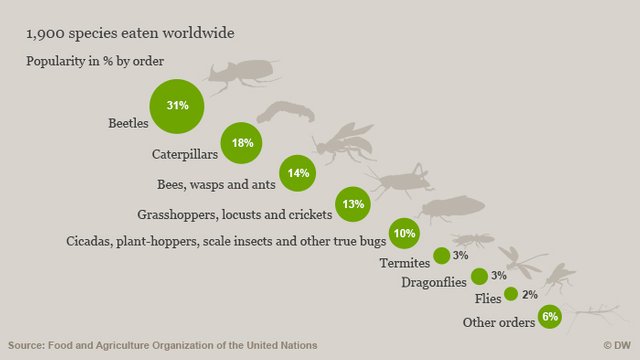
3. Insects are an efficient, nutritional, eco-friendly source of protein
Click the arrows to view the next image.
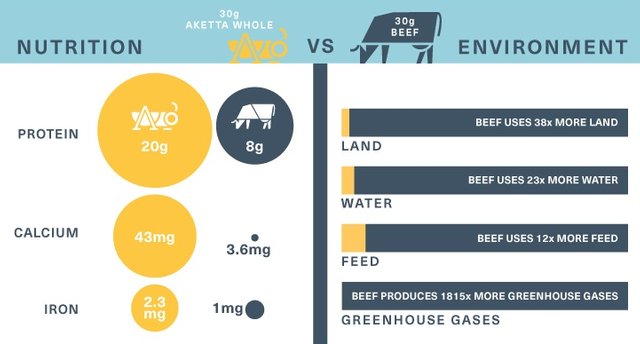
Most of the comparisons of protein sources above use crickets, as they are the bug leading the way for the west to begin adopting Entomophagy. Crickets are the so-called “gateway bug”.
As the market grows, though, more studies will be done on various insects and it will be interesting to see what science finds about the nutritional profiles of the different kinds.
With around 1,900 edible insects, there’s a lot that we still have to learn about how they can benefit the human body.
Comparisons between cricket protein and beef protein, and various stats:
- Crickets are an estimated 20x more efficient source of protein than cattle
- Crickets produce 80x less methane than cattle
- 100 gallons of water creates:
- 6g of cow protein
- 18g of chicken protein
- 238g of cricket protein
- Crickets are 69% protein, while sirloin is only 29% protein
- Crickets contain 9 essential amino acids and have the ideal omega ratio of 3:1
- Crickets also contain B12, iron, zinc, magnesium, sodium and potassium
- Cricket flour contains more calcium than milk and more iron than spinach
- It’s estimated that just 1 single hectare could produce 150 tons of insect protein per year
- A family of 4 eating food made with insect protein just 1 day a week for one year, would save 650,000 liters of fresh water
- Cricket farming is inexpensive, non-toxic, non-hazardous, environment friendly and non-chemical. (GMI 2016), a stark difference from farming other protein sources such as beef, chicken, or pork.
4. Insects are a potential source of feed for aquaculture and poultry farmers
Feed for fish
With aquaculture producing half the world’s consumable fish, sustainable developments will need to occur in order to keep up with the growing demand. One of the primary needs is fishmeal, and insects can efficiently and cost-effectively provide the solution in a natural way, as bugs are a natural food source for fish in the wild.
With the production of aquaculture increasing rapidly, researchers are already starting to develop feed based on insect proteins for use as fish food (and for livestock), in hopes that it will soon be able to supplement fishmeal.
Feed for chickens
Insects are also a natural food source for poultry, which is another segment of farmed human food which can benefit from insects as a feed.
As this industry has expanded in developing markets, complimentary food sources for poultry have included grasshoppers, crickets, cockroaches, termites, fleas, bees, wasps, and ants. (Ravindran and Blair, 1993)
But beyond merely consumption by chickens as food, eating insects may play a role in the overall health of the bird, due to chitin, a polysaccharide found in their exoskeleton and which boosts the chicken’s immune system. This can eliminate the need for dangerous antibiotics in the poultry industry, which have in the past led to human bacterial infections. (FOA, 2013)
By using insects as feed for farmed fish and poultry, demand for those human food sources can continue to be met in a sustainable way that is healthy for the fish and poultry, and for the people who consume them.
Approximately how much might this segment of the market be worth financially?
Well, Zoe Leavitt, a Retail & Food Technology Analyst at CB Insights, said on a webinar recently that the total global market for insect-based protein could expand to $371 billion when other applications, such as livestock feed or industrial uses, are considered.
That’s fairly sizable, considering the market is just now beginning to take shape.
5. The increase in urban farming trends dovetails perfectly with raising insects
There’s a rapidly growing trend toward urban farming of vegetables, including rooftop gardens, community gardens, and especially indoor vertical farming. Each of these methods seeks to maximize use of confined or indoor spaces to compost bio-waste and grow food organically and with an eye toward sustainability.
Converting warehouses to vertical farms
Vertical farming in particular has become an investment trend. Philips Lighting has invested heavily into vertical farming research & development. It’s becoming a trend in places with limited land area, such as Singapore.
Many other companies are also aiming to grow crops inside small areas, maximizing production by using multiple layers stacked on top of each other, with specialized lights to mimic natural cycles. It has led the vertical farming market on a projected growth path of 30.7% CAGR between 2015 and 2020. At that time the market is expected to reach $3.88 billion.
The use of warehouse space to produce vegetables is quite similar to how insects can be raised in urban environments. Existing buildings – whether aged past their original use, or in a state of abandonment – can be remodeled simply and quickly for use in rearing insects as food.
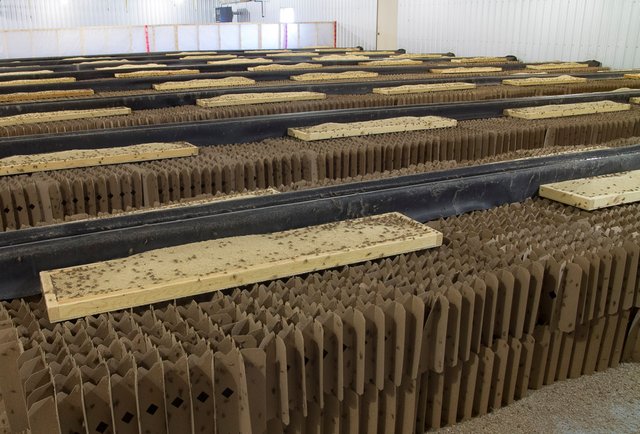
Cricket rearing facility in North America. Source: Entomo Farms
Insect farms are often cheekily referred to as “mini herds” or “mini livestock”, but these businesses have a number of advantages because they:
- require minimal space
- don’t compete directly with food already used for human consumption
- have a high demand which outstrips their supply
- have high reproductive rates
- create cash inflow in a short time period
- have high to very high financial returns in many cases
- are nutritional and a part of human nutrition
- convert feed to protein efficiently
- are relatively easy to manage
- are easily transportable
- are often easy to raise and do not require in-depth training
(FAO, 2011b)
Beyond these reasons, since the enterprise is not resource intensive it’s much easier for marginalized groups – such as people who do not own land – to get involved in the process, and rearing the insects can be done by individuals of all ages, including young kids and the elderly.
On a mass-production level, companies are able to use small warehouses with a minimum of employees to produce crickets for protein on a scale that simply isn’t possible with most other food sources.
The UN is predicting that 80% of the world’s population will live in cities by 2050, and around 80% of the land suitable for growing food is already in use. So the opportunity to produce a healthy and nutritious source of protein in confined spaces of urban environments has the potential to provide massive benefit to humanity over the next 30+ years, along with being very profitable for companies in the space.
6. It’s an entirely new food category poised for massive growth and already attracting investors
According to a 2016 Arcluster Research report, “The global market for edible insects is expected to reach $1.53 billion in 2021, growing at a CAGR of 70.6% between 2016 and 2021.” That’s nearly double the rate of vertical farming growth over essentially the same period of time.
Figures vary slightly between different market research analysts, but they all agree on one thing consistently: rapid growth of the edible insects market over the next 5-7 years is going to happen.
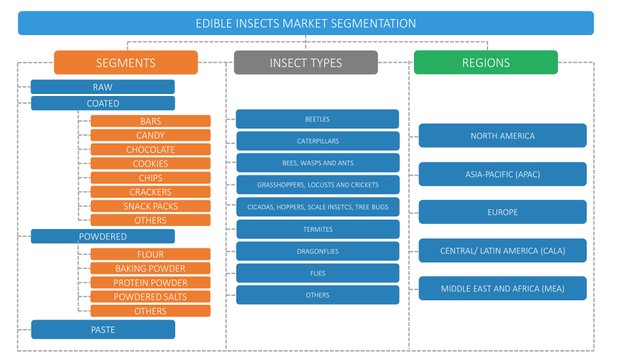
Segments within the edible insects market - Arcluster Research
Unlike other recent dietary trends, insects are not simply a “new superfood” or a new spin on a previously undesirable (but healthy) vegetable, such as kale chips. The edible insect market is an entirely new food category unto itself!
Again, though, that’s specifically in the west, because elsewhere 2 billion people are already chowing down in the rest of the world.
But mostly they’re just frying them – the growth is going to come from innovative methods of farming and end-use product segmentation of the market.
Europe and North America alone are a huge demographic area, and the one with the least edible insect penetration. For an example of current growth in just one segment of one western market, consider the meal replacement space that cricket protein bars have entered and begun to make headway in. According to IBS World, it grew from $2.1 billion in 2006 to $3.2 billion in 2016.
And while EXO’s $4 million Series A funding last year (including investment from rapper Nas) might not have made it instantly famous on the level of PowerBar or Kind Bars, I’ve been consistently seeing EXO bars at health food shops all over the US, from grocery stores to airport snack kiosks, parked on the shelf in the same area with those other famous bars.
Not bad for a product based on “icky” insect protein, right? Because it tastes nothing like bugs! And it tastes everything like a really delicious and healthy natural food bar.
EXO is not the only one, either. Chapul also makes cricket protein food bars, and has grown nationally over the past few years since they pitched on Shark Tank and billionaire investor Mark Cuban did a deal with them.
Chirp’s Chips, a cricket protein based chip, recently appeared on Shark Tank as well (after a successful kickstarter campaign) and Cuban once again invested.
Clearly, Mark Cuban sees something in the growth of his first investment with Chapul, or he wouldn’t invest in the market a second time with Chirp’s Chips. And what he’s seeing are these 8 points you’re reading here! 😉
But EXO and Chapul are not alone – insects are showing up in snacks and meals at Silicon Valley startups, grasshoppers landed on the menu at Seattle Mariners baseball games, and even a member of the Zuckerberg family has plunked down cash, as Arielle Zuckerberg along with Investors Circle funded Tiny Farms, a cricket farming startup.
And while there’s certainly a bit of “trendy” element to some products – eg, each Chirp’s chip contains only 1 single cricket – the trendiness will be necessary to change western opinions about eating insects, one small step at a time.
As that happens in the west over the next few years, the category will likely explode with growth and over time morph into a more stable protein food source market based on global impact and profitability, rather than simply because it’s the latest organic fad.
From Global Market Insights edible insects market analysis report (2016):
*[The] Insect Protein bars market is expected to grow significantly at over 42% CAGR up to 2023. Protein bars mainly use cricket, mealworm, and grasshopper and are promoted as energy bars.
Bug based flour applications may observe 42% CAGR and surpass USD 165 million by 2023. They are primarily used in making biscuits, cookies, bread, muffin, desserts, soups, smoothies, and others. Cricket and mealworm are used in powder form and are found in flour products.
Other major application includes chocolates, chips, live feeder insect, roasted food, pasta, biscotti, and insect protein shake. They are also used in alcoholic beverages such as centipede and scorpion vodka and whiskey.*
7. Innovation will improve breeding, growth, and harvesting methods for the rest of the world
It’s obviously just speculation to predict what innovation most needs to take place in the edible insects market. If I knew exactly what the future needed, I’d just go do it and make a fortune, right?
But there are some basics that clearly need to be worked out with regard to farming and rearing bugs, and then getting them produced into consumer products. These are areas where innovators stand to make a great deal of money if they can provide a better solution.
- Farming techniques are still in their infancy, even for the largest North American producers of cricket flour.
As mentioned above, Tiny Farms recently received Silicon Valley backed funding to develop it’s secretive cricket farming methods.
Those developments are likely to be secretive for the near future, as producers aim to lock in their right to proprietary methods of scale, to increase production beyond just raising crickets for pet shops and bait shops, and to begin raising them on a mass scale for broader human consumption.
In SE Asia, many of the crickets sold by street vendors are just wild caught using light traps. I’ve been to small rural operations in the Cambodian countryside, and it’s very rudimentary. Studies have also been taking place over the past several years to examine the impact on wild cricket populations and health due to over-trapping.
In Thailand, there are some 20,000 cricket farmers already, with the market mature enough that Vice published a story titled “Insect Farming Can Buy You A Toyota In Thailand“. Check the link for images of some of the more ‘modern’ cricket farms in Thailand, and you’ll understand why innovation has a long way to go, but will also make a major difference in global insect farming as new techniques and technologies are discovered.
- Rearing and feeding for the ideal nutritional profile
Along with the facilities used to raise crickets and other insects, what they eat will need to be studied and experimented with in order to examine the effects of certain foods on their nutritional profile.
If it’s possible to change the taste of a cricket based on what the cricket spends it’s life eating (see the next point), then it seems plausible that it’s possible to tinker with the values of proteins, vitamins, and minerals that an insect contains as food, too.
Experiments with flavors based on feed sources
Crickets (and potentially other bugs) take on the flavor of what they’re fed, so in the future it may be possible to have apple cinnamon flavored crickets, or basil flavored crickets, based entirely on their food source.
Additionally, farmers are experimenting with removing all feed the final hours or days of the crickets life, to allow them to pass all food they’ve consumed, in a quest for the cleanest cricket protein possible. A slightly gross thought, but one that makes sense.
Now if EXO can just figure out how to make a cricket taste like PB&J without additional flavorings, they might be able greatly increase their margin and sell bags of them to NBA players as high-protein PB&J flavored snacks!
- Ethical methods of termination including freezing and shredding
While very little is known yet about whether or not insects can feel pain (current science suggests they do not), companies are still looking for the most humane termination process possible.
It does have a bit to do with optics – after all, the debate is still ongoing over whether or not insects are even allowable for a vegan diet, and if so, that demographic would be a big demo to have. But it also is about respect for the animals, and a quest for maximum efficiency.
Most producers are currently freezing the live crickets, which basically kills them slowly but painlessly. This is also efficient for subsequent shipping, and keeps the cricket in it’s original state.
Another method which is instantaneous is shredding, which even though it’s instant and the bugs probably don’t feel anything anyway, the idea seems a bit morbid.
However, as companies vertically integrate and the industry matures, there may be benefits of efficiency for simply dropping live crickets into the grinder to become ground-up cricket meal.
- Production of flour and the issues with using whey protein dryer facilities and bug legs
On a small scale, if you wanted to make cricket flour at home, it seems simple in theory but apparently gets complex due to the makeup of the cricket. I have yet to attempt it, but in reading what others have gone through (because I was planning to do it), the difficulty appears to be the oily nature of the cricket, and the toughness and fineness of their legs and antennae.
Basically, they tend to gum up a blender or grinder, and bug parts get stuck everywhere. However, some have reported success dehydrating them in a food dryer, then grinding them in a coffee grinder, then milling them on a small home flour mill. Seems like quite the process for a small amount of cricket flour. #dedication
The same problem with the legs applies to commercial protein dryers. I’ve been told by friends with connections in the mass-production protein industry that there have been tests by large-scale producers to work in cricket protein, but they gave up very quickly due to the legs and antennae sticking in any and every crack of the drying machines.
The issue is less about finding a tiny bug part in your whey protein, although that would be “gross” too. The issue was with potential blowback for the product being considered not kosher / halal / vegan etc if those bug parts were found. After spending several days to completely clean the dryer after a test, the company said no more cricket protein!
So innovation in the commercial machines for the production of bug protein will be a big part of the industry’s growth. And if you’ve ever attended a food or packaging convention, you understand how highly technical and honestly quite remarkable some of the machines are that produce the packaged foods that people buy in grocery and convenience stores worldwide.
- Use in consumer food products to go beyond merely trendy to becoming the foundation of the nutrition
EXO and Chapul are proving that cricket protein tastes great when used in bars, and I can say from experience they work as a meal replacement. I took 2 boxes with me on a recent trip to Central America, and saved some coin and potential bouts of Montezuma’s Revenge by skipping local meals and eating cricket bars instead!
But what other uses will it have? What products based on beef, chicken, pork, or fish, could be replaced with insects?
Already we’ve got culinary dishes in development by creative chefs looking to appeal to the eyes as well as the taste buds. There’s cricket flour, which has a variety of uses, but doesn’t “rise” like wheat flour, so it faces many of the same challenges coconut flour has faced in terms of baked goods.
There is the food bar and meal replacement market, including protein shakes, and that seems to be picking up steam already. There’s the snack goods, which is a natural extension of what most of the worlds eats bugs as, and a delicious and much healthier way to snack as well.
What about jerky, burgers, nuggets, as pizza toppings, as a combination crouton / protein source in salads, as tapas for dipping, used in tortillas and flatbreads for lower-carb variations of many cultural foods…get some foodies together to brainstorm and the list will probably grow to 100 different concepts.
- Lowering costs across the board
One of the biggest challenges faced by the western cricket / insect protein market at the moment is the cost. Considering what goes into rearing them and turning them into flour and then a consumable product, though, it’s not surprising that right now cricket flour goes for as much as $35 a pound.
But it hasn’t hindered growth with the early adopters, and in a similar market the cost of premium coconut water didn’t slow growth the past decade either. As costs come down from the bug all the way to the end consumer, though, it will allow for more mass-market products to be created and sold.
Unlike coconut water, which is basically a type of flavored water sold as an alternate to sugary drinks and juices, insect protein is a solution for basic human needs and survival over the next few decades. This gives a deeper urgency to innovation in the edible insects market that coconut doesn’t have (it is much more about creating and then capitalizing on current health trends, and continually increasing revenues).
8. The edible insect market projections look similar to the growth of coconut water over the past decade
Let’s look at a recent market that is comparable, coconut water. Clearly there are differences compared to the insect market, but for the consumer back in the mid 00’s, coconut water was something novel, strange, and not understood – similar to eating insects today.
Vita Coco is the market leader, and they started in 2004 as the first “packaged” coconut water in the USA, after a now-famous encounter by the founders with some Brazilian girls at a bar who were jonesing to crack open a coconut like they did back home.
As of 2016, a mere 12 years later, Vita Coco:
- Has an estimated annual revenue of $420 million
- Is the market leader with an estimated ~50% of the market
- Dominates the UK market, which is itself £100 million and the leading market overall
- Still only has 5% household penetration even with those numbers
- Launched their own branded coconut oil in late 2013, which now represents 15% of revenue, and will make up 25% within 2 years
- Had early celebrity investors like Madonna, Demi Moore and Red Hot Chili Peppers frontman Anthony Kiedis
- Was the fastest growing non-alcoholic beverage in the UK for 3 straight years (as of 2016)
“Ok, cool” you might be thinking, “but what’s the leading brand in the coconut water space have to do with crickets?”
The answer is, growth! And the lessons that can be learned from a similar market in very recent history (and still growing today) which can be applied to the edible insects market.
Take a look at the 2 charts below. The first one is coconut water sales from the top 3 brands, from the inception in 2004, until 2013.
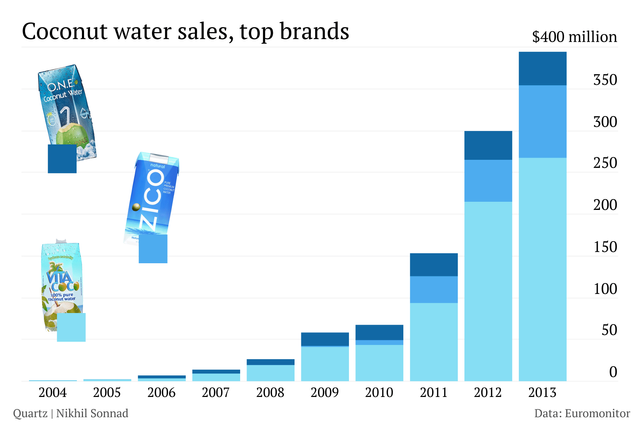
If you carry it forward until 2017, the coconut water market is estimated in 2017 to be over a billion $, and expected output is projected to go from 134.2 million gallons in 2016, to 332.8 million gallons by 2021. (BusinessWire 2016)
And that’s just the coconut water, it does not include all the offshoots that have grown along with it – coconut oil, coconut chips, coconut flour, coconut milk, coconut sugar, coconut meat, coconut fiber for use in textiles, coconut charcoal for use in water filtration systems, coconut husks which are used for fertilizer and soil replacement, and more.
The majority of that growth – at least in the west – has stemmed from the rise of a somewhat trendy beverage positioned as a healthier alternative to sugary drinks (and even somehow positioned as healthier than water). It’s also come from a considerable amount of funding being pumped into the space, as investors are still drooling over disruptive brands.
I believe that edible insects market will grow at a similar speed initially, but will reach a tipping point within the next 5 years in the west, which will catapult the market over the next 10-20 years beyond what coconut products could possibly hope to attain.
And my reasoning is simple: there’s much, much more at stake with insect protein than there is with coconut water or coconut products, as wonderful as they are.
Here’s a freely published graph from the $4,500 edible insects report from Global Market Insights – their projections look similar to what the coconut water market actually experienced the past decade.
U.S. Edible Insects Market size, by application, 2012-2023 (USD Million) (Global Market Insights, 2016)
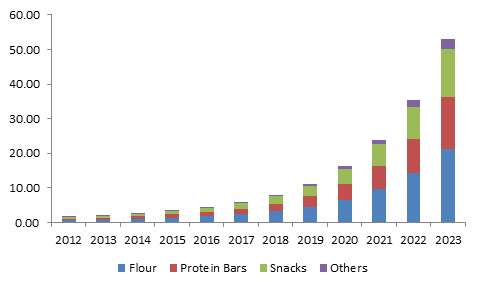
Is this getting you excited about eating bugs yet?
The edible insect industry is a wave that is rising in the same manner as that of coconut water, and for those who determine to catch it, I’m very certain it’s going to be a long, gratifying, and ultimately very prosperous surf.
I’m a converted “squeamish westerner” who now eats insects on a regular basis, because they’re nutritious, delicious, and sourced locally. It’s truly just a change of mindset, and once you eat a few, you kind of forget all about the fact you’re eating creepy-crawly bugs.
Besides the crunchy SE Asian roadside fare, I’ve also been eating EXO cricket protein bars for a couple years during my travels, and find they provide me with the energy I need to sustain an intense and challenging schedule. And they taste amazing.
If someone like me can be converted to eating crickets, beetles, and scorpions – as grossed out as I was originally – it’s only a matter of time before western culture shifts from “ewwww!” to extolling the virtues of eating bugs. When that happens, and innovation of the rearing and processing systems drastically improves the efficiency of getting the protein from bug to consumer, the growth of the industry will be parabolic.
The perception is already starting to change, especially among millennials who are notably more health conscious and more well-traveled than other generations as a whole.
The combination of natural diet and far-flung travel is leading many to take chances and experiment with eating insects when they’re out in the frontier, and then as trendsetters they’re reporting back to their friends at home or publishing through their online media channels about what eating bugs is like, and how nutritious they actually are.
But the biggest takeaway here is that this isn’t just an #instafad! It’s far more valuable. Eating insects is the best solution that the planet currently has to survive and thrive as earth’s population swells by 2 billion hungry human mouths over the next 30+ years.
Chowing down on bugs might not be as sexy as space travel, robotic butlers, and self-driving cars, but in some ways it’s fundamentally more necessary to the survival of our species, and it does have the potential to be both highly disruptive and highly profitable.
I’m convinced an investment in this market is going to pay multiples over the next 5 years (and for decades beyond), and it’s going to be one of the major focuses of Venturopoly going forward, an Ento Fund / incubator of sorts.
We have already invested into one startup in this space which is looking to bring products to market in 2018, and there is more on the way!
I've also put insect protein to the test by living as a strict Entovegan for most of 2017, including a 90 day body transformation eating only vegetables and insect protein.

I didn't reach my % goal during those 3 months, but I'm still sticking with the program because I feel great, so why not keep going for it! I really believe that eating insects is not just a fad - it's the future of food.
Do you have experience with eating bugs or insect protein? Leave a comment, let me know!
FOR MORE INFORMATION ON EDIBLE INSECTS: entomophagy.org
 I'm Josh Galt, an artist, athlete, & entopreneur
I'm Josh Galt, an artist, athlete, & entopreneur
I'm the founder of Venturopoly OÜ, a frontier investment livestyle startup.
My passion is exploring the frontier in search of opportunities for growth and development, and I’m convinced that Entomophagy (eating insects) is the #FutureOfFood!
I'm also perpetually chasing sunshine & h2o, while getting a healthy dose of adventure sports, coconuts, and minimalist architecture with expansive views.

Upvoted. sorry, I don't know etiquette, just made my account yesterday, just wanted to let you know I cited you in my post about entomophagy recipes: https://steemit.com/introduceyourself/@mickeyd/my-name-is-mic-and-i-ll-teach-you-how-to-eat-bugs
Downvoting a post can decrease pending rewards and make it less visible. Common reasons:
Submit